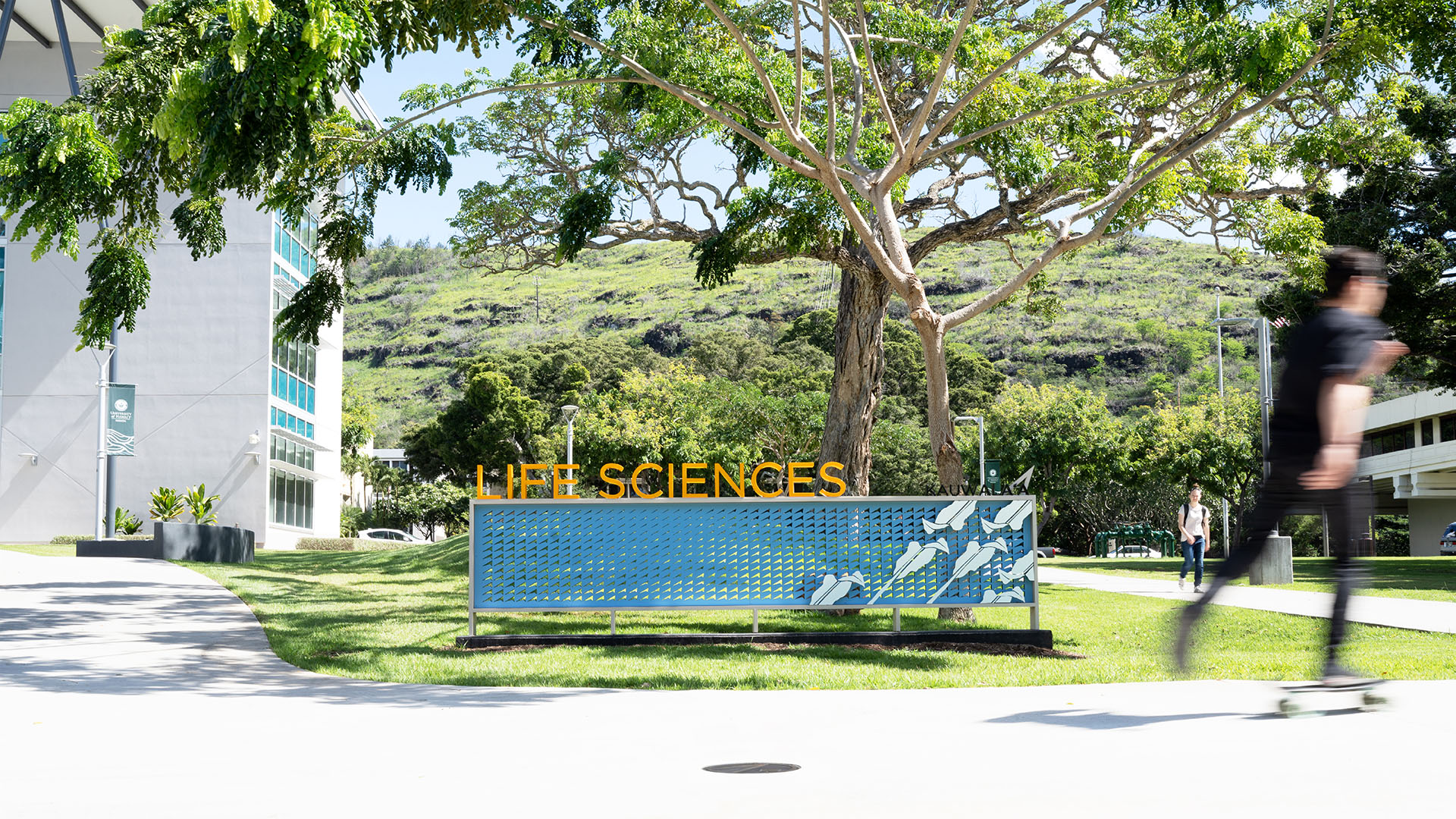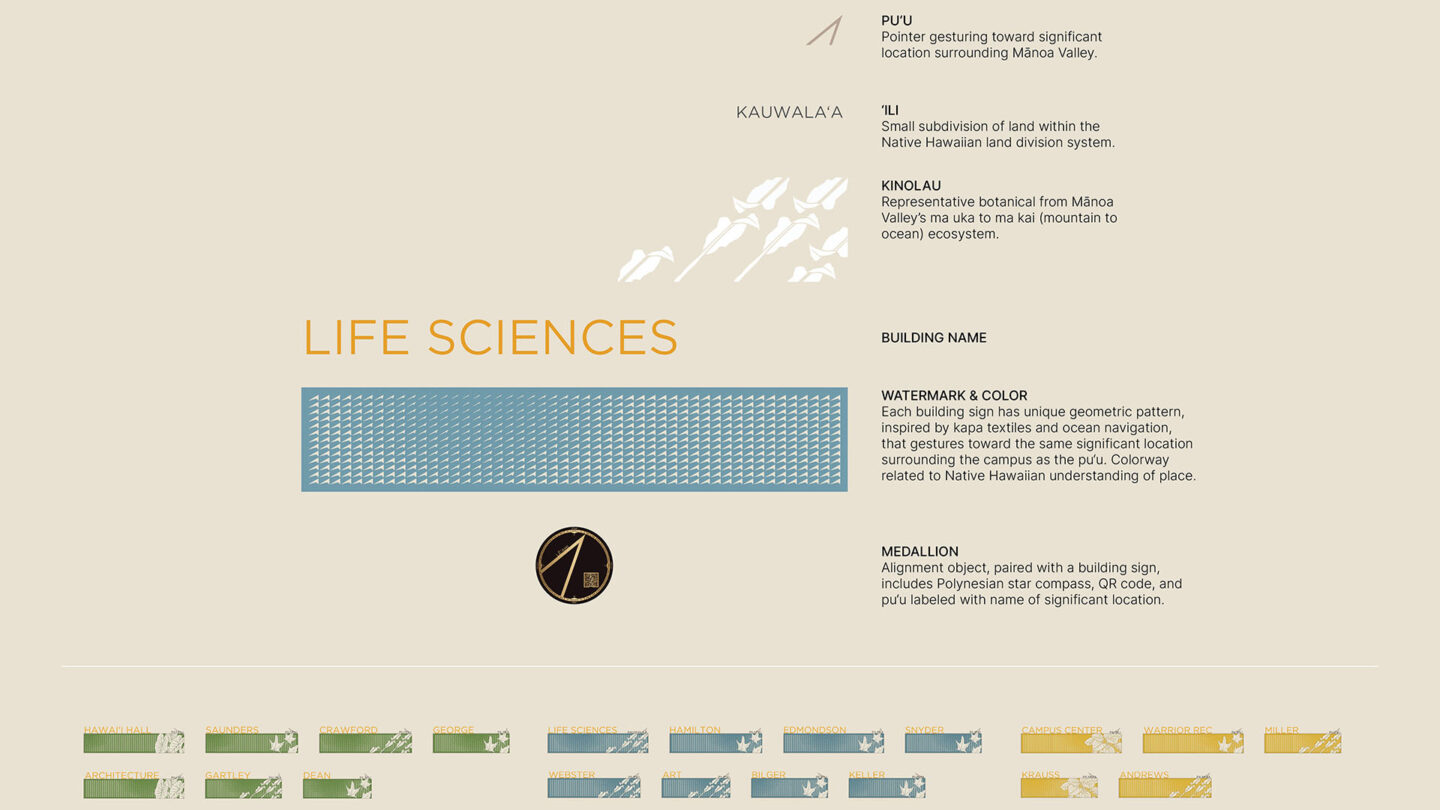Beyond Wayfinding
The new University of Hawai’i wayfinding system displays a blend of the Hawaiian and English languages in physical and digital formats and invites campus visitors to actively interact with Hawaiian navigation tools and geospatial body alignment practices.
Agency
University of Hawai’i, Sig Zane Kaiao
Practice Area
Client
University of Hawai’i
Industry

The Challenge
Representing indigenous voices in Hawai‘i and around the world has never been more important. Their knowledge systems are inherently tuned to local contexts and have to a great extent, been erased from daily life.
Students today do not want to be a party to the institutional marginalization of indigenous and minority communities. They expect their institutions of higher learning to be at the forefront of the fight for social justice. As universities across the country and around the world confront their pasts, the source of their lands, and the actors that built their institutions, they must enter into dialogues with the very communities that they have historically marginalized through their actions.
Students, especially those that identify as being part of an underrepresented population, have to be an integral part of this process. They must be included in imagining a new way forward and be partners in building a more just and equitable world.
Project Vision
The Office of Vice President of Administration initiated this project with the understanding that the physical campus, which was primarily built before the Hawaiian cultural renaissance, needs to transform itself to better represent Native Hawaiians and take an active role in regenerating and normalizing Hawaiian language and culture.
From the outset, the project was envisioned as a deeply integral part of campus infrastructure.

Life Sciences’ medallion with pu’u pointing toward Le’ahi (Diamond Head). Each medallion orients viewers to a unique significant location or natural feature surrounding the campus valley.
Tom Takata Photography

The new, official campus map is overlain with white boundaries tracing the ‘ili that compose the campus. Navigation lines tie medallions and building signs together, while increasing situational wayfinding skills.
Tom Takata Photography
Design + Execution
Early work was informed by shadowing prospective students and their families on a dozen campus tours and conducting one-on-one interviews with them. This process revealed an overwhelming expectation to see more physical representation of Native Hawaiian culture on the campus and a desire to actively participate in its perpetuation as a student. The Beyond Wayfinding project has sparked cross-departmental conversations and resulted in the generous contributions of more than 100 faculty, researchers, and students.
Led by two Principal Investigators, one an architecture professor and the other a user researcher and design strategist, the team was composed of undergraduate and graduate research assistants from graphic design, architecture, UI/UX, and business, the majority of which were raised in Hawai‘i and included several that identify as Native Hawaiian. Supported by the UH Native Hawaiian Program Office, the inter-professional team conducted generative design workshops and constructed prototypes and full-scale mock-ups on the campus to gather contextually-informed feedback. Final design concepts formed the basis of an RFP that required the inclusion of a Native Hawaiian design team to build upon and further the design system.

Wahi pana (significant places to Native Hawaiians) are paired with key buildings. This network is intended to increase awareness about the natural elements and cultural sites that surround the campus.
Tom Takata Photography

Medallion for Bilger Hall gestures toward Wa’ahila Ridge. Medallions are outlined by the 32 houses of the Star Compass that is utilized by many Polynesian navigators.
Tom Takata Photography

Building Sign components and system collection. The three primary zones of the campus, the Quad, McCarthy Mall, and Legacy Path are differentiated through color, pattern, and sets of botanicals.
Tom Takata Photography

Partial 1:1 mock-up for Legacy Path building sign. Full-scale prototyping, user interviews, co-creation sessions, and paper prototypes of the digital ecosystem have informed the project since its initiation.
Tom Takata Photography

The unique geometric patterns are inspired by kapa textiles and are an abstraction of ocean conditions. The perforated pattern reveals the landscape beyond and gestures toward a paired, significant location.
Tom Takata Photography
Project Details
An exceptional execution used not only to display information but also increase awareness of native Hawaiian culture and its traditions.
Most schools will have a land acknowledgement of the indigenous people, but this project takes that a step further and tells you the story of the land, the culture, and the people throughout campus. Wayfinding is used as both navigation and storytelling. It activates what is currently on the land as well as brings indigenous voices and context to life. It does that in a really fun, approachable, and practical way. As a student I would have loved discovering all the navigation symbols and hearing the stories.
The "Beyond Wayfinding" powerfully centers indigenous narratives about place and landscape; helping users not only navigate throughout the modern college campus but also understand their location relative to the island as a whole.
Design Team
University of Hawai’i
Brian Strawn, Karla Sierralta (UH, conceptual & systems design)
Sig Zane Kaiao
Kūha’o Zane (conceptual & graphic design)
Sig Zane (textile & graphic artist)
Nalani Kanaka’ole (cultural practitioner)
Collaborators
Global Specialty (design-build contractor)
Two Twelve (fabrication consultant & campus map designer)
CRĒO Industrial Arts (fabrication)
Photo Credits
Tom Takata Photography (photography)
Hunter Wells (videography)
Coby Shimabukuro-Sanchez (videography)
Tre Zamora (videography)
Jack Ames (videography)
John ‘Eiwa Colburn IX (videography)
Open Date
July 2022





